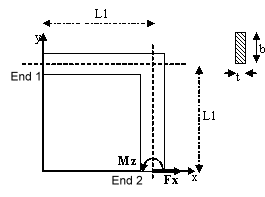This test lets you check analysis results for rectangular
beams, in the context of a buckling case.
You will use 1D meshes.
Reference:
-
W. FLIGE, MC GRAW-HILL, Handbook of Engineering Mechanics, New York, 1962
-
J.H. ARGYRIS, Finite Element Method - The Natural Approach, 1979
 Specifications
Specifications
Geometry Specifications
|
Length: |
|
|
Height: |
|
|
Thickness: |
Analysis Specifications
|
Young Modulus (material): |
|
|
Poisson's Ratio (material): |
|
|
Inertia: |
|
|
Mesh Specifications: 21 nodes, 20 beam elements. |
|
|
Restraints (User-defined):
|
|
|
Loads:
|
|
 Results
Results
The following table presents the results for buckling eigen values.
|
|
Argyris theory |
CATIA beam |
|
Test 1 |
1.088 |
1.088 |
|
Test 2 |
624.77 |
624.77 |
To Perform the Test:
The Lateral_buckling_rectangular_beam.CATAnalysis document presents the complete lateral buckling case, and includes the tests 1 and 2.
To compute the case, proceed as follow:
-
Open the CATAnalysis document.
-
Compute the analysis and generate an image called Deformed Mesh.

